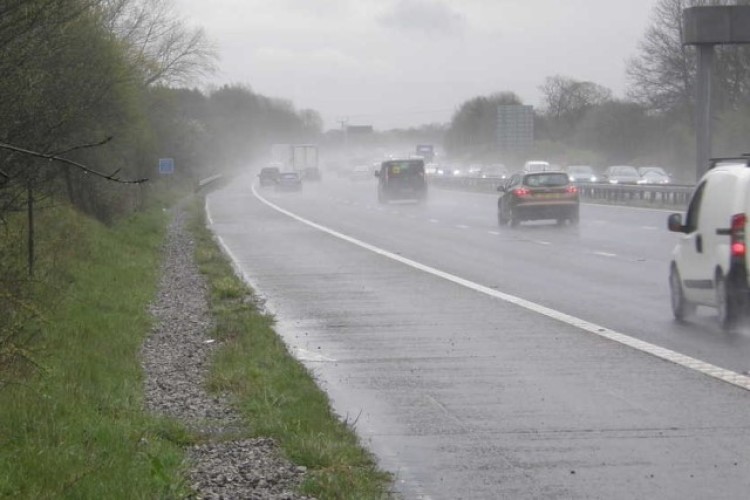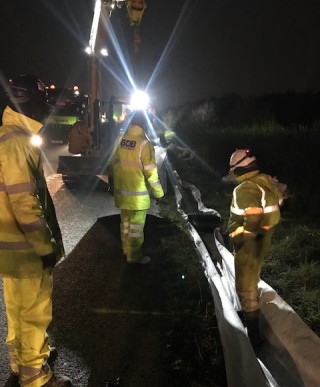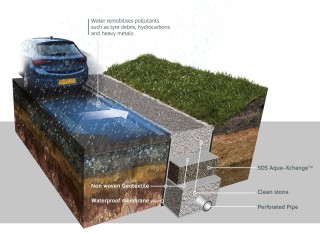Aqua-Xchange, made by Somerset firm SDS, is a granular material that uses ionic exchange and filtration to remove soluble and solid pollutants from surface water runoff. The M56 is its first application.
Contractor BDB Special Projects installed the new treatment media into an existing filter drain along the M56 to prevent pollution of a vulnerable Cheshire stream, which receives runoff from a 1km stretch of the motorway via a single outfall.
Aqua-Xchange has been developed by SDS to capture and retain copper and zinc, poisonous metals released through the abrasion of vehicle tyres and brake pads, which dissolve in surface water during heavy rain.
Further installations of Aqua-Xchange are already in the design stages for locations across the UK. Highways England’s priority outfall programme has identified 2,500 high-risk pollution locations and is looking for practical and affordable treatment solutions.
The managers of Highways England Area 10 commissioned a study of the Mag Brook outfall, a small tributary that runs through farmland to the south of Lymm. Water from Mag Brook flows via another stream, Bradley Brook, into a small lake known as Lymm Dam, a popular local beauty spot and nature reserve.
SDS market development manager Jo Bradley worked on the M56 project from its earliest stages. She said: “The risk assessment revealed the stream was vulnerable to pollution because of the high traffic volumes travelling to and from Manchester and the airport. There was very little water flow in the brook to dilute the runoff from the motorway. It confirmed a treatment scheme was needed to clean the water significantly, reducing both the soluble copper and zinc levels to bring them within permitted levels.
“There was no space to build SuDS ponds or other vegetative features behind the carriageway to treat the metals, or to install a manufactured stormwater filter to capture the pollutants. So, it would have been extremely problematic to mitigate the pollution risk otherwise. Using SDS Aqua-Xchange also meant less excavation and less disruption. There will also be no need for maintenance during the 12 to 15 years design life.”

Filter drains are stone-filled trenches that capture suspended solids as they run off to the sides of the carriageway. However, they are not capable of capturing soluble pollutants. When added to the filter drain, a layer of SDS Aqua-Xchange uses the processes of adsorption and ionic exchange to capture the metals dissolved in the runoff as they filter through the material. The chemical process forms unbreakable bonds, so the pollutants are retained even in heavy storms and during winter road-salt applications.
Contractor BDB Special Projects installed 184 one-cubic-metre bags of Aqua-Xchange. The bags were set out at seven-metre intervals along each side of the carriageway prior to installation to facilitate even distribution.
As there were cabled services in the filter drain, a vacuum excavator was used to remove the existing stone to the desired 400mm depth. A team followed directly behind to line the trench with a geotextile membrane, then a grab wagon was used to lift and discharge each big bag of Aqua-Xchange material into the trench and it was raked level. The old stone was taken away for cleaning and reuse.
The 250mm layer of Aqua-Xchange was covered with a geosynthentic grid for surface stabilisation, then with a final layer of clean stone, designed to capture initial suspended solids and gross pollutants before the water is treated by the Aqua-Xchange beneath. The water then continues to percolate through the non-woven geotextile wrap and filters through a further layer of stone before entering the perforated pipe at the bottom of the trench. The cleaned water is discharged into Mag Brook.
BDB director Ben Dobson said: “We were able to complete the works during 10 overnight closures, with minimal disruption to the travelling public. Through our experience in filter drain refurbishment works, we understand that detailed planning of the logistics is key to successful and safe delivery. By making a few small changes, introducing Aqua-Xchange into the process became seamless, leading to efficient outputs not dissimilar to traditional filter drain replacement methods.”
Got a story? Email news@theconstructionindex.co.uk





